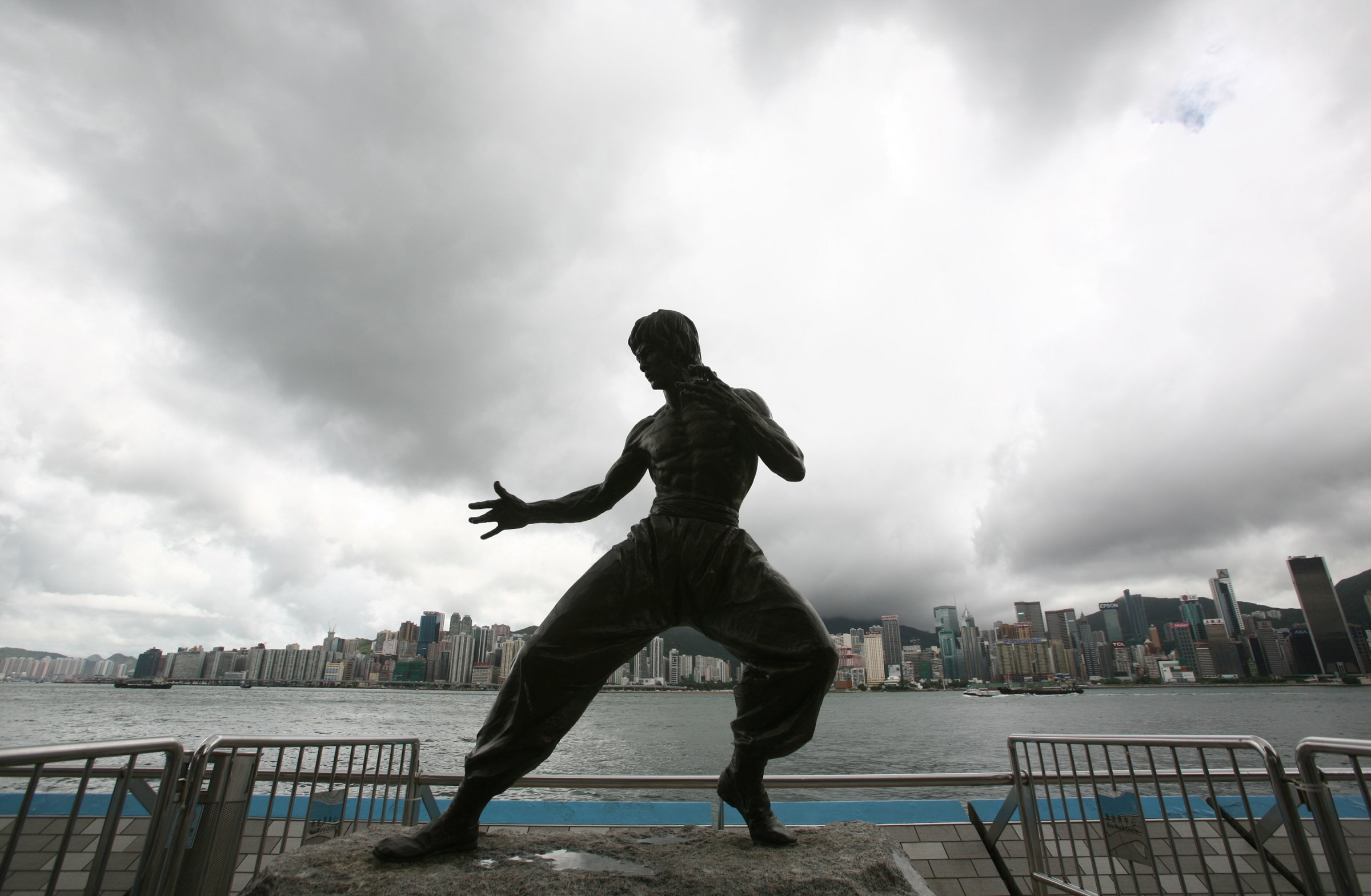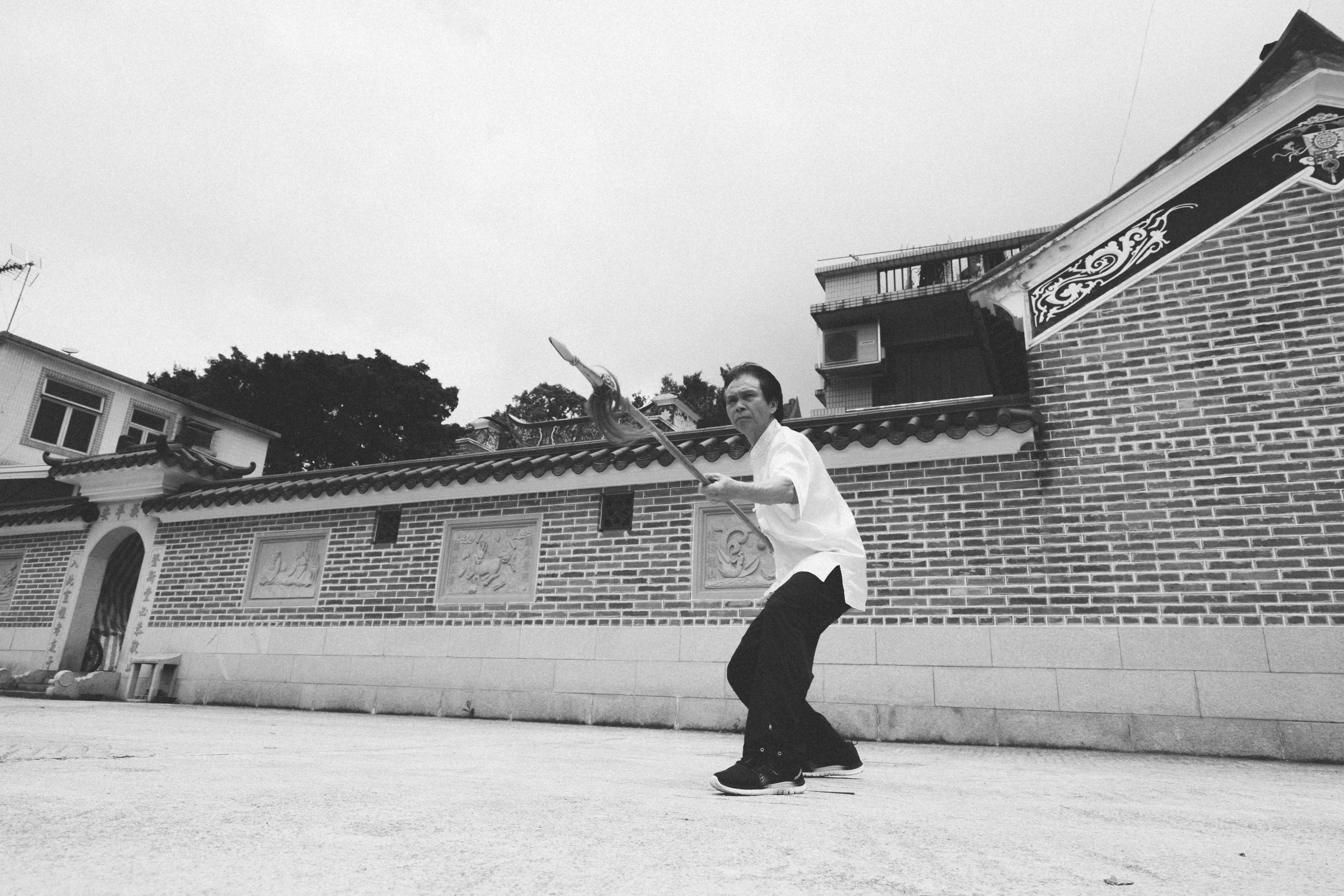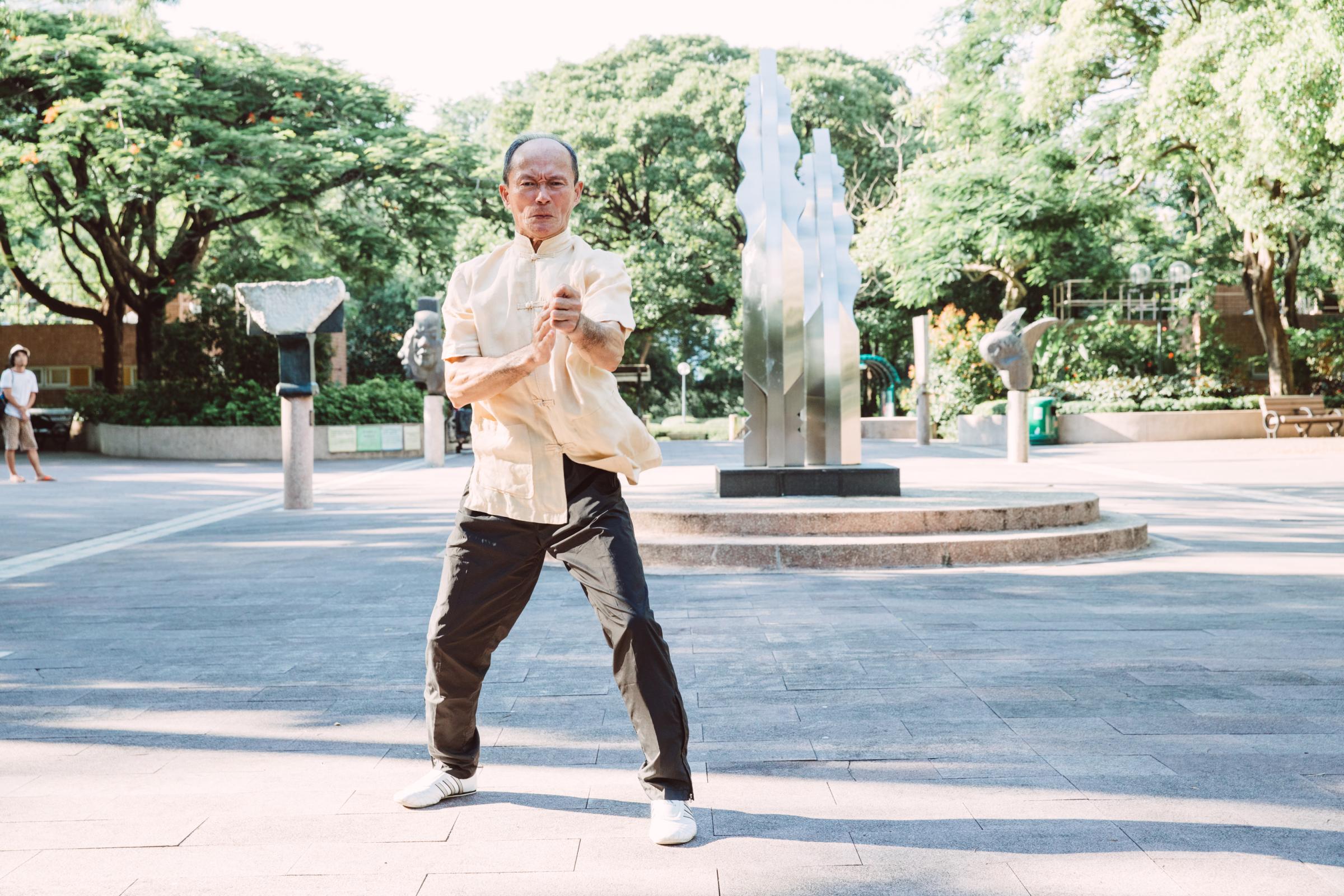
“The waters of the Yangtze roll to the east, heroes come and go like foam on the waves.” — The Romance of the Three Kingdoms, Luo Guanzhong
There are a couple of time-honored ways to find a kung fu master, cinema teaches us. You can begin a journey of a thousand miles with a single step, climb a misty mountain, and pluck a chrysanthemum to drop into the palm of your intended sifu. Or, you take a beating on the stone steps of a monastery and show up the next morning to stand vigil under the crabapple trees. Again and again with the beating and the vigils until one day the gate creaks open and wordlessly you follow your new master inside.
But finding the sifu of Jiangxi Bamboo Forest Praying Mantis kung fu — a fighting style inspired by the movements of the predatory insect — turns out to be way easier. It costs less than $100 by taxi from Hong Kong Island’s banking district. From there, you drive through an undersea tunnel into the glass and concrete cacophony of the Kowloon peninsula, and then follow the articulated trucks north along one of the highways that carve through the Nine Dragons range after which Kowloon is called, and into the New Territories.
Despite its beckoning, adventurous sounding name, the New Territories is, in reality, a 952-sq-km buffer of suburban housing developments, scrap yards and scrub-covered hills between Hong Kong and China proper. Here, the skyscrapers cede to pylons piercing the mist, and abandoned shipping containers rust among thickets of bamboo. At the end of one country road is Wo Hang village. And next to its post office, in a nylon track suit and waving through the drizzle, is sifu Lee Chun-lam: head of the Jiangxi Bamboo Forest Praying Mantis dynasty and master of the unicorn dance.
On a walk around Wo Hang, taking in a community hall hung with red banners for his son’s marriage, 68-year-old Lee recalls the unicorn dances here that would be performed at weddings, Chinese New Year celebrations, and other auspicious occasions. They first stirred his interest in kung fu. Men would don papier mâché unicorn heads and caper to cymbals, flashing tongues and shaking silk tails as neighbors lit firecrackers. “When I was kid, there was nothing to play with, and I was intrigued when I heard there were unicorns out and about. I was attracted by how animated and like animals they were,” Lee tells TIME.
Unicorn dances, and the form of Praying Mantis kung fu that Lee mastered, came to Hong Kong by way of the Hakka, a migrant people. Many landless Hakka — the word literally means guest families — settled in what is now the New Territories about 300 years ago. As a minority ethnic group in often hostile territory they relied on their fighting skills to survive. Martial arts was so embedded in their culture that when Lee — a 10th generation Hakka settler in Wo Hang — was growing up almost everyone studied kung fu.
Today, things are very different. Hong Kong has reared three generations of martial-arts stars — from the legendary “Little Dragon” Bruce Lee (no relation) and Shaolin Master Killer’s Gordon Liu, to Jackie Chan and Crouching Tiger Hidden Dragon’s Chow Yun-fat, to Donnie Yen of Star Wars: Rogue One. But the kung fu that has a cult cinematic following the world over, and continues to inspire legions of mixed martial arts fighters, faces multiple threats back home.
Lee is one of the rare Hong Kong masters whose variant of kung fu is managing to survive — just about. Although Wo Hang’s remote location means he currently has just eight disciples, some of those disciples have taken on acolytes of their own in the city and there are a couple more Bamboo Forest Praying Mantis masters in Hong Kong besides him. Once a week, he also crosses the border to teach a class in the nearby mainland Chinese city of Shenzhen.

Other forms of Hakka kung fu, however, are at risk of extinction. A sifu of Tung Kong Chow Ka, a different style of Praying Mantis kung fu, tells TIME that his style has fewer than 100 practitioners. Another sifu, the preternaturally ripped 62-year-old Yau Wan-wah, has five remaining disciples but no regular place to teach them his Iron Ox Praying Mantis, a style renowned for toughening its practitioners’ fists and forearms. And snowy haired Lam Yue-fau, who is 87 this year, is the only living master of one of the southern Chinese style known as Lam Gar Gau.
Some styles have gone altogether: Wat Shek Gau (“Rolling Rocks Teaching”), a type of martial arts practiced by quarry workers from Hakka villages, disappeared from Hong Kong as mining and stonework were phased out; Lau Man Gau (“Drifting People’s Teachings”), also of Hakka origin, is close to extinction.
“The root is in danger,” Chao Hing, the CEO of the International Guoshu Association, tells TIME. If the root withers altogether, he says, Hong Kong loses not just methods of self defense but “an embodied system of knowledge and communication.” These range from unicorn dances, to the use of weapons adapted from farm tools, to techniques inspired by the motion of stone-grinding rice into flour.
In fact, the decline of Hong Kong kung fu has been going on for half a century or more. Long before Bruce Lee enjoyed cinematic success in the 1970s as Hong Kong’s first global superstar, some of the martial arts he studied were already losing their hold on the Hakka villages of the New Territories. (The film star was trained in Wing Chun kung fu, which some experts say bears more resemblance to the Hakka style of fighting than it does to the styles of the Cantonese ethnic majority.)
Work in the impoverished, hardscrabble Hakka settlements was scarce, and jobs in Hong Kong’s nascent manufacturing sector were low paid. Many men, therefore, took advantage of Hong Kong’s status as a British colony to emigrate to the U.K., to be hired in the restaurants and takeaways of London, Birmingham and Manchester. Others signed up as seamen on the countless cargo ships that came through Hong Kong’s busy port. Wherever Hakka men found employment — from Liverpool to Rotterdam to Sydney — they sent for their fellow villagers and clansmen to join them. In this way, entire villages across the New Territories were emptied in a short space of time. Lee Chun-lam tells TIME that around 90% of the Hakka in Wo Hang left.
Meanwhile, development and population booms put the squeeze on rents. Many kung fu masters fled to Hong Kong in the late 1960s to escape the chaos of Mao Zedong’s Cultural Revolution. They set up their schools on Kowloon tenement rooftops — in those days, among the cheapest premises to be had in the urban area. But as waves of refugees continued to arrive from mainland China, demand for rooftop space spiked. A roaring economy, and scarce land area, meanwhile kept the price of other forms of property prohibitively high. Half way across the world, kung fu was a sensation. From late March to mid October 1973 six Hong Kong kung fu films held the No. 1 spot at U.S. box offices. But in Hong Kong itself, taking on the relatively extravagant square footage required for a busy martial arts gym was simply beyond the means of most sifu.
In recent decades, the pressure on kung fu has only intensified. The proliferation of different forms of entertainment, and a far greater choice of forms of exercise — from squash courts to skate parks to hiking trails and regular gyms — means that the territory’s young people have a plethora of ways of keeping themselves entertained and fit. When they do express an interest in combat sports, it is in its currently modish forms — Muay Thai, for example, or mixed martial arts. Kung fu is often seen as outdated or, even worse, brings to mind the slapstick form of fighting found in Jackie Chan films.
‘Endless grinding will make a sword treasured’
The last bastion of Tung Kong Chow Ka Southern Praying Mantis style is on the ninth floor of a nondescript gray building in Kowloon’s Mong Kok neighborhood — an area known for its street food, cheap shopping, brothels and occasional triad fights.
On a recent Wednesday, 13 barefoot students scuttled across a vinyl floor among boxes of promotional calendars and polythene wrapped unicorn masks. Fixed to the wall was a rack holding swords, staffs, and a spear of the kind used in the elaborate, twirling, Plum Blossom routine. On another wall, extractor fans sucked in grilled pork fumes from the apartment next door, instead of fresh air.
Master Li Tin-loy walked among his acolytes in a frog-button shirt. The sifu used a wooden staff to tap against straining calves and quads. Then he laid it on a fold-out table while he made minute adjustments to the rotation of wrists, or corrected the protrusion of knuckles.
When not attending to his students, Li — a former police officer — talked about the common origin of the various praying mantis styles. “One day there was a monk that noticed a fight between a mantis and a bird. The mantis won and he was wondering how and why,” he tells TIME. “Later on he caught a mantis and was just observing the way that they fight, the way they interact and then slowly developed a style based on its movements.”
Tung Kong Chow Ka Southern Praying Mantis is centered around a few seemingly simple sets of those movements. At Li’s gym, there are no flying kicks or Bruce Lee–style, falsetto yowls. Instead, there is the dull, repetitive whack of shin or elbow or fist on flesh, among which Li moves with a mantis’ coiled tension. Mastery comes through repetition and refinement. But since each movement has — to practitioners — infinite depth, mastery can be a long process. It takes five to six years of training before a student is even considered perfunctory.
The grandmaster of the Tung Kong Chow Ka, Lau Shui, moved to Hong Kong in the early part of the last century. Even then, and especially to a new arrival from Qing dynasty China, Hong Kong’s urban environment would have seemed fantastically alien. In the exciting, hothouse atmosphere of a foreign enclave, Lau broke away from the conservative attitudes surrounding martial arts and began teaching a form of praying mantis style to women. It was an astonishing act at a time when respectable Chinese females still thought it vaguely indecent to be seen outside of the home — but he also lost none of his toughness. Among his disciples was Ip Shui, whose feet the grandmaster would scorch with the bowl of his pipe to toughen them up.

Ip eventually proved worthy of carrying on the lineage, and taught Li for more than a decade, subjecting him to the same sort of arduous physical punishment. To this day, Li will invite an interlocutor to grip his neck and give it a squeeze. Astonishingly, nothing gives. It’s as if the years have grown him an invisible exoskeleton.
Between Li and Ip, and Ip and Lau, there was the close relationship between student and master of the kind once integral to the transmission of kung fu. Historically, students would travel for miles, and endure all sorts of privations, to find a master like Li, but the sifu acknowledges that such dedication today is a rarity. “The new generation doesn’t seem to be interested in learning this kind of cultural heritage — mainly because [they find it] really hard work and really boring,” he tells TIME.
There’s a Chinese adage he likes to quote to his followers: “Endless grinding will make a sword treasured, in the same way that plum blossoms acquire their scent after a bitter winter.” Nevertheless, his fear is that none among the new generation will be sufficiently dedicated to carry the lineage.
In Wo Hang, Lee shares the worry when it comes to the future of his Jiangxi Bamboo Forest Praying Mantis style. “When you start teaching without having picked up the whole package, there’s a bit less there,” Lee says. “The kung fu gets passed on again but less and less gets inherited, until finally it’s lost.”
‘A conversation between the past and the present’
The final keepers of Praying Mantis kung fu may not even be people but instead a bank of quietly humming servers at Hong Kong’s City University — located in the same Kowloon Tong neighborhood where Bruce Lee was raised, educated, and, in 1973, died.
Here, Professor Sarah Kenderdine (a specialist in creating interactive and immersive museum exhibits) and Professor Jeffrey Shaw (a leading figure in creating art from new forms of media) have been collaborating with the International Guoshu Association on what Shaw calls “a conversation between the past and the present.”
Using the same sort of motion-capture sensors employed by video-game developers, 1000-frames-per-second cameras and virtual-reality projections, this project at City University aims to record each of Hong Kong’s disappearing kung fu styles with digital accuracy before their last masters retire, become infirm or pass away.
On a recent Tuesday, Li performed the fundamental movement groups of Tung Kong Chow Ka Southern Praying Mantis in a black-walled room in Kowloon. The room was equipped with scores of scaffold-mounted video cameras. Dressed entirely in black and with almost 100 motion-capture sensors suckered to his body and head the sifu looked more insectoid than ever.

Shaw tells TIME that data taken from the recordings of Li will be fed into various installations, which are currently displayed in an exhibition entitled 300 Years of Hakka Kung Fu at the university’s School of Creative Media. One of the displays recreates a typical training hall: there is the scent of incense, information on Chinese medicines, and recordings of the thumps and thuds made at Li’s Mong Kok studio. Another display called “Re-Actor” shows different perspectives of a martial artist thrusting and whirling a spear. When Shaw presses a button on a panel in front of the display, it reveals the shapes of movements through space and time, or the traces left by the paths of the martial artist’s limbs and weapons.
So far, around 40 kung fu styles have been recorded by Shaw, Kenderdine and their team, including Jiangxi Bamboo Forest, Tung Kong Chow Ka Southern, and Iron Ox. The hope is that the work will strengthen the argument for the creation of an institute for Chinese martial studies in Hong Kong, which, Chao says, is the surest way to ensure that local forms of kung fu will be preserved.
For now, the hope is that City University’s work will create a renewed interest in kung fu, attracting the attention of young, digital-savvy Hong Kongers at a time when a desire for greater autonomy or even independence from China — which resumed sovereignty of Hong Kong from Britain in 1997 — has forced many here to define and isolate a uniquely Hong Kong culture as opposed to a generically Chinese one.
Back in 1962, a renowned Bamboo Forest sifu called Wong Yuk-kwong came to Wo Hang village in the New Territories. That was the summer 9-year-old Lee was mesmerized by dancing unicorns, and when he learned the visiting sifu also practiced the unicorn dance he resolved to become a disciple.
But Lee’s family was poor and couldn’t afford the monthly tuition, which worked out, in those days, to the local equivalent of $1.70. Instead he would stand at the edges of the classes. Every evening, alone, he would then practice the movements he had seen. Eventually, noting the boy’s dedication, the master consented to take him on as his disciple, waiving training fees and asking only that he brew him a pot of tea every evening.
Fifty-four years later, things are brewing once again for Lee, and for Praying Mantis kung fu.
—With reporting by Kevin Lui / Hong Kong
More Must-Reads from TIME
- Cybersecurity Experts Are Sounding the Alarm on DOGE
- Meet the 2025 Women of the Year
- The Harsh Truth About Disability Inclusion
- Why Do More Young Adults Have Cancer?
- Colman Domingo Leads With Radical Love
- How to Get Better at Doing Things Alone
- Michelle Zauner Stares Down the Darkness
Write to Joseph Hincks / Hong Kong at joseph.hincks@time.com



